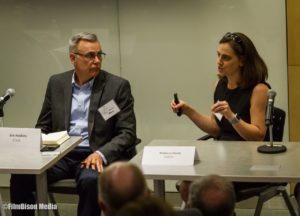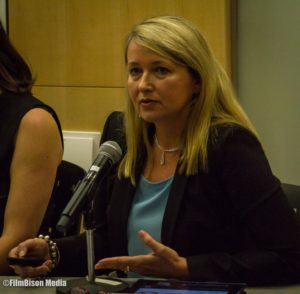
By BARBARA ENGLEHART, MATTHEW SHONMAN, and TRAVIS HIGH
At the Energy and Sustainability Extravaganza at The George Washington University (GW) on February 24, 2017, attendees learned about what universities in the DC area are doing to reach their sustainability goals and commitments. But, as some of the panelists acknowledged, no one person, office, or even university can bring the high-level change and results alone. At some point in almost any project, whether in higher education or elsewhere, partners are needed.

So after the panel of campus sustainability officers shared their sustainability priorities and challenges, the Extravaganza sponsors took the stage to display their sustainable solutions.
Moderated Dr. Nandini Mouli, President of eSai Consulting, there were two panels featuring representatives from a total of ten companies. Dr. Mouli gave a short introduction, noting the timeliness of bringing companies that offer solutions to a range of clients, including in higher education. Each speaker was asked to give short introduction to their company.
Here are the highlights of that discussion:
- Juan Soto – Sales Engineer at Carrier Enterprise

About: Carrier Enterprise offers Variable Refrigerant Flow (VRF) technology. VRF is a heating, ventilation, and air conditioning (HVAC) system that can distribute coolant across many rooms depending on the need, essentially creating different thermal zones. Two VRF systems are available: a heat pump system to heat or cool single, large open spaces; and a heat recovery system, able to simultaneously heat and cool multiple spaces using one system.
Benefits: Soto said that the VRF technology can be good for schools, offices, and multifamily buildings. The product is now also available for single houses. The system can transfer heat from a full room to emptier spaces in a building. It has several other benefits, including that the components are lightweight and quiet, with a cost over the life cycle.
- Nikola Jovic – Energy Consultant at DC Sustainable Energy Utility
About: DCSEU is a local energy efficiency utility that was established by the Council of the District of Columbia to reduce gas and electric consumption in DC and to create jobs for DC residents.
Benefits: According to the program requirements, 10% of energy savings are to come from low-income communities. DCSEU achieves this goal by providing technical assistance and financial rebates to customers and connecting customers to share knowledge. They also work with DC universities, including GW, Georgetown, and American University.
- Jennifer Taranto – Market Sales Manager at Johnson Controls

About: Johnson Controls offers a range of products that include building-wide systems integration, smart technology, data on energy use, and Internet of Things. Multiple low-voltage technologies are converging in smart buildings in ways that can help to increase interoperability of technologies. A building could adjust lighting and other systems based on the number of people inside. It could be aware of when people enter and leave. Moreover, buildings can be “self-healing” – parts of a building that need repair could automatically contact service mechanics before a human becomes aware of the problem.
Benefits: The goal is to use the connectivity of devices brought by IoT to lower costs throughout the building life cycle, manage risks, and increase comfort of buildings. For universities, Taranto spoke about the opportunities to optimize instructional, facility, administrative, safety, and security systems on university campuses. The company has a successful case study at nearby Bowie State University in Maryland.
- Jean-Marie Bergeal – CEO of MeteoViva Inc.

About: MeteoViva is a German-based company offering the next generation of HVAC control strategy designed to significantly increase building efficiency. The technology uses a thermodynamic model of the building and factors in the weather forecast, building use, and energy prices to generate the most energy and cost effective control strategy. In addition to directing the Building Automation System, it constantly monitors indoor conditions to react in case of unexpected circumstances.
Benefits: Bergeal reports average savings of 20% across a portfolio of 65 buildings, with the accompanying reduction in carbon footprint. The small initial investment and the shared savings model typically bring a fast return on investment. In addition to economic and environmental benefits, clients report better indoor climate and fewer complaints. Buildings using the technology include educational facilities, office buildings, factories, airports, etc. MeteoViva is now proud to count American University as its first U.S. client.
- Suzanne Rowe Barrett – Partner and Vice President of Sales at ThermaXX

About: Rounding out the first five vendors, ThermaXX presented its removable insulation jackets and smart monitoring technologies that are used to insulate pipes, boilers, and the like, achieving energy efficiency savings while also improving on the physical safety of these installations.
Benefits: By offering smart insulation solutions, ThermaXX also gives customers the chance to measure and verify their energy savings. Sensors can wirelessly update the user with the savings and provide a heat loss report. Their main clients are hospitals and universities, some of them local. The savings can be big – a New York hospital saved $50,000/month in energy costs with the insulation.
- Tom Horner – Vice President of Engineering at Water Management, Inc.
About: Water Management is a DC area company that does water audits and water efficiency programs.
Benefits: Water is an essential resource. Water Management works with customers to audit their water usage and develop customized solutions to reduce usage and achieve savings.
- Bill Brandon – CTO of Industrial Ecosystems Partners

About: Industrial Ecosystems Partners is a firm that looks at wet organic waste utilization and conducts infrastructure research and development for controlled environment agriculture. Their aim is to sell “not a product, but a way of thinking.”
Benefits: One example of the kind of technology Brandon employs, a containerized modular anaerobic digestion system, has been installed in a building in Manhattan. This project uses biogas for onsite generation of power and heat. Brandon spoke about the BIQ House in Hamburg, Germany as another interesting example – the first algae-powered building in the world.
- Jim Haskins – Internet of Things Specialist at Cisco
About: Cisco is one of the largest technology and networking companies in the world. According to Haskins, forms of connectivity are changing with the evolution of IoT. The challenge for many organizations is figuring out how to securely connect systems and gather, visually analyze, and share data. With respect to building systems, one of their areas of work is to find ways to parse data at the edge of network, instead of transmitting useless data to the cloud.
Benefits: Cisco works with clients to find value from correlating disparate data and find ways to share data, for instance, with police, transportation, and water infrastructure. Haskins spoke about the need for a multi-tiered approach to cybersecurity and managed threat defense.
- Rebecca Shealy – Project Architect at VMDO

About: VMDO Architects designs learning spaces for educational institutions that express a school’s ideal academic mission; enhance teaching and learning aims; and raise the bar with healthy, sustainable environments that double as teaching tools. VMDO aims to collect data on energy use and rainwater capture.
Benefits: VMDO works with institutions to integrate sustainability into the learning environments, allowing students to engage with the technology. They have had several successful projects, including James Madison University’s Wayland Hall – the first LEED Platinum residence hall renovation in the U.S., the net-positive Discovery Elementary School in Arlington, VA – currently, the largest net-zero elementary school in the country, and the Greer Environmental Sciences Center at Virginia Wesleyan University. At the Greer Center, strategically-placed sustainable features (such as a green roof) are accessible to students who can observe and monitor the building’s use of energy, water, and material resources.
- Cynthia Maves – Electric Vehicle Business Development Manager at Nissan

About: The Nissan Leaf is a 100% electric car built in the United States with 8 year, 100,000 mile warrantee. The vehicle has a 107-mile range on a single charge.
Benefits: Among the benefits cited by Maves, there are: lower maintenance, fuel, and repair costs; total cost of ownership savings; no tailpipe emissions; and for institutions that buy them, the potential for brand awareness. Situations in which buying a fleet of these cars might be useful would include employee pools, delivery, security vehicles, airport shuttles, etc. Universities such as Penn State have purchased Nissan Leafs. In addition, when asked by an audience member about the battery’s life cycle, she said that the battery can be used as a backup power source for buildings or battery pack for utilities. When it is no longer usable, the lithium ion component is recyclable.
The Energy and Sustainability Extravaganza featured a series of panels, including a CWEEL luncheon, presentations by university sustainability officers and by vendors with sustainable solutions, town hall discussion with government leaders, and networking reception.


Photos courtesy of Film Bison Media


Leave a Reply